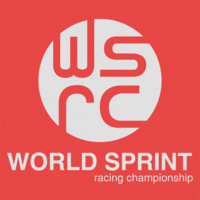World Sprint Racing Championship: Difference between revisions
(Created page with "{{Championship Infobox |name = World Sprint Racing Championship |Logo = File:WSRC logo.png |series category = Grand touring, touring cars |count...") |
No edit summary |
||
| (2 intermediate revisions by 2 users not shown) | |||
| Line 1: | Line 1: | ||
{{Championship Infobox | {{Championship Infobox | ||
|name = World Sprint Racing Championship | |name = World Sprint Racing Championship | ||
| | |logo = File:WSRC logo.png | ||
| | |category = Sportscars, grand touring | ||
| | |locale = Worldwide | ||
|founder | |founder = World Motor Racing Association | ||
|inaugural season | |inaugural season = [[1962 World Sprint Racing Championship season|1962]] | ||
|last season | |last season = 1970 | ||
|tyre suppliers = {{Dunlop}}<br />{{Goodyear}}<br />{{Michelin}}<br />{{Pirelli}} | |||
|current season = 1962 World Sprint Racing Championship season | |||
|tyre suppliers = Dunlop | |||
|current season | |||
|}} | |}} | ||
'''World Sprint Racing Championship''' was an international racing series which, compared to the endurance-minded World Sportscar Championship, concentrated on shorter grand touring races (usually around 150 kilometres). While | '''World Sprint Racing Championship''' was an international racing series organised and sanctioned by World Motor Racing Association (WMRA) which, compared to the endurance-minded World Sportscar Championship, concentrated on shorter grand touring races (usually around 100-150 kilometres depending on the category). While borrowing some homologation rules from the FIA the series was not directly affiliated with them, thus allowing the series to have more relaxed manufacturing requirements, with the occasional experimental prototype also allowed to compete in the same class against series production cars. In general, any car that could easily run in street-legal form was allowed to race in one of the five categories defined by engine displacement. | ||
The series came to an end after the 1970 season, as racing | The series came to an end after the 1970 season, as increasing professionalism in motor sports throughout the 1960s resulted in massively increased costs for the organising body. This in addition to a number of financial mismanagements led to WMRA declaring bankrupcy in the winter of 1970-71. | ||
Unlike most other racing series of the time, the series was unusual in that highlights footage of each race was recorded and preserved for later use. In the first season every race was captured on 35mm colour film, however operating a fully-fledged film crew was too costly and in later seasons local television stations were usually employed to capture the footage on two-inch videotape. Although colour tape was used as much as possible (despite colour TV not being widespread until late 1960s), in some locations it simply was not available so only black-and-white footage is available from some races. After the bankrupcy of WMRA, the archived footage changed owners a number of times before being bought by Reject Motorsport Channel, who have subsequently rebroadcast the series as a part of their "Classics" programming. | |||
[[Category:Series]] | [[Category:Series]] | ||
[[Category:World Sprint Racing Championship]] | [[Category:World Sprint Racing Championship]] | ||
Latest revision as of 18:23, 23 January 2019
| World Sprint Racing Championship | |
|---|---|

| |
| Category | Sportscars, grand touring |
| Country/Region | Worldwide |
| Founder(s) | World Motor Racing Association |
| Inaugural Season | 1962 |
| Last season | 1970 |
| Tyre supplier(s) | Template:Dunlop Template:Goodyear Template:Michelin Template:Pirelli |
| Records | |
World Sprint Racing Championship was an international racing series organised and sanctioned by World Motor Racing Association (WMRA) which, compared to the endurance-minded World Sportscar Championship, concentrated on shorter grand touring races (usually around 100-150 kilometres depending on the category). While borrowing some homologation rules from the FIA the series was not directly affiliated with them, thus allowing the series to have more relaxed manufacturing requirements, with the occasional experimental prototype also allowed to compete in the same class against series production cars. In general, any car that could easily run in street-legal form was allowed to race in one of the five categories defined by engine displacement.
The series came to an end after the 1970 season, as increasing professionalism in motor sports throughout the 1960s resulted in massively increased costs for the organising body. This in addition to a number of financial mismanagements led to WMRA declaring bankrupcy in the winter of 1970-71.
Unlike most other racing series of the time, the series was unusual in that highlights footage of each race was recorded and preserved for later use. In the first season every race was captured on 35mm colour film, however operating a fully-fledged film crew was too costly and in later seasons local television stations were usually employed to capture the footage on two-inch videotape. Although colour tape was used as much as possible (despite colour TV not being widespread until late 1960s), in some locations it simply was not available so only black-and-white footage is available from some races. After the bankrupcy of WMRA, the archived footage changed owners a number of times before being bought by Reject Motorsport Channel, who have subsequently rebroadcast the series as a part of their "Classics" programming.